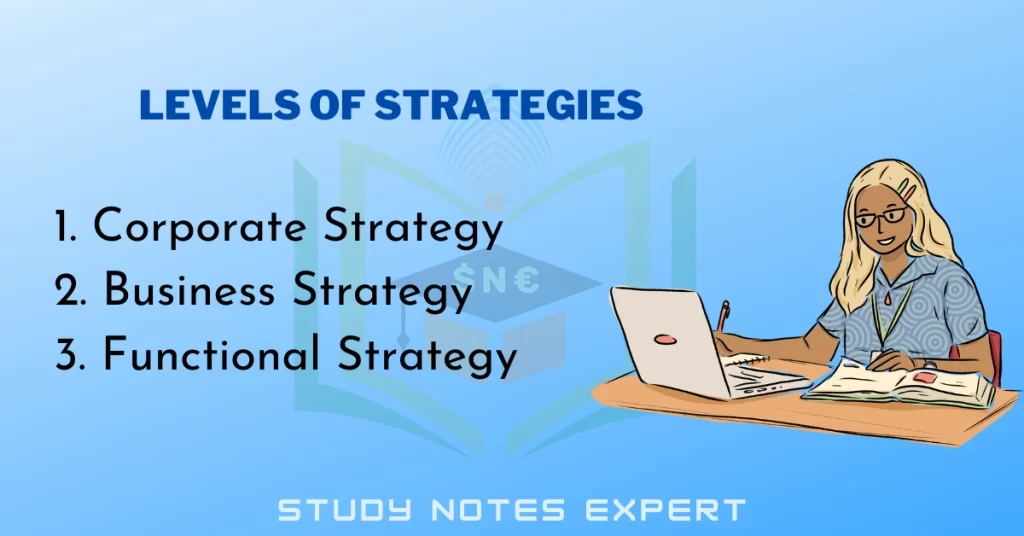The scope of strategy defines the position in the market as the company envisions it. In essence, it provides specifics of the industry or market within which the firm wants to investigate, or more precisely. Also, we will discuss the levels of strategies.
Scope of Strategy

The scope of markets in which the company will be competing shortly. The strategy’s scope includes the following:
1. Analyzing Current Position
The following points must consider while studying the current market situation and scope of strategy:
i) Where does the business place itself?
ii) How do the company and its brand match the company in which it situates?
iii) What is your targeted audience?
iv) What are your perceptions and misconceptions regarding the brand currently?
v) What kinds of marketing communications are helpful? If they’re effective or not.
2. Changes Made
The scope of strategy helps analyze the following aspects:
i) What are the latest developments in the field?
ii) What kind of changes are happening?
iii) What are the factors that influence the selection of the audience?
iv) How will you deal with the consequences of technological and economic changes?
v) Which diverse local, national, and international occasions could affect the organization? What is the purpose of competition?
vi) What diverse external factors could affect the business’s operations and how trade carries?
3. Future Forecast
The scope of strategy includes the analysis of the previous policies and the formulation of future policies through consideration of the following elements:
i) Where would the company like to be short?
ii) What are the short-term and long-term objectives of the company?
iii) Are Secret strategies’ for companies remaining effective?
iv) What do you think are the plans of the company to grow?
v) How competent are staff members?
vi) What will the brand be able to reach in the next few years?
The scope of strategy is understanding three types of methods and demonstrating how the strategy’s scope will depend on the model’s definition. Here are the three different models of business:
- Strategists are making an innovative business model while they are leading an initiative to develop a strategy for the corporate level.
- Strategists enhance various aspects of a business model if they lead an initiative to implement a business-level strategy.
- Strategist optimizes one or more aspects of a business model if the person is in charge of a strategic initiative to implement a functional-level strategy.
The term “strategic planning” is unclear in various ways, not just separating the corporate strategy from the business-level and functional system.
Levels of Strategies

It is essential to note that strategy is a factor at all company levels. After managers have decided, “What is our business, what will it be, and what should it be?” They can then establish ambitious and achievable performance goals and formulate strategies to meet them. The goal is the development of a structure of objectives covering the entire organization from bottom to top and developing a strategizing hierarchy to reach the goals at every level of the company. The three levels of strategy are three strategies:
1. Corporate Strategy
Corporate-level strategies, also known as Corporate Strategies, are top management strategies designed to oversee the general working of the business and achieve the desired levels of performance. The levels of strategies outline the organizational goals and activities in different areas, such as divisions and product lines, technology consumers, their requirements and requirements, etc.
Corporate strategies direct an organization to transform into who it “wants to be” to increase performance. For instance, when the attempt Nokia to create an operating system of its own did not succeed in 2011, Microsoft and Nokia made an alliance that saw Nokia able to manufacture phones that ran Microsoft’s Windows operating system. With this alliance, Microsoft was able to gain access to an industry that was one of the most considerable cell phone makers. Nokia was able to keep its market share thanks to the aid of the merger.
2. Business Strategy
Business strategies are design to be different for each piece based on environmental variations. Business-level strategies are often known as strategic business plans or strategic Business Unit (SBU) level strategies. A Strategic Business Unit (SBU) helps understand the distinct market segment served by the business. The business levels of strategies help meet customers’ requirements from various features and offer them value. Thus, meeting the needs of customers in diverse segments assists the business in maintaining and increasing its competitive edge. For instance, Domino’s Pizza owes its success to its Turnaround strategy, which produced positive results because of all employees’ efforts to achieve the straightforward goal, which was to “have a clear win against competitors in a taste test.”
3. Functional Strategy
The functional level refers to the operational departmental levels and divisions within an organization, like finance, marketing, HR, R&D, and more. The value chain and business practices influence the strategic decisions made by functional groups. The levels of strategies then translate the strategies into action plans that apply to different departments. The operational level of an organization is a source of input for higher-level strategies, such as corporate-level and business-level strategies.
An organization must implement the plans to ensure that the strategy is effective. Methods that are higher level depend upon the level of functionality to obtain information about resources and capabilities from the techniques developed at the business and corporate levels. Marketing strategy, for instance, is broken down into various functional groups of strategies like price strategies, distribution plans, sales strategies, marketing strategies, etc.
What are the 5 Business Level Strategies?
The business level strategies are:
1. Cost Leadership 2. Differentiation. 3. Focus 4. Performance excellence 5. Innovation
What are the 5 Elements of Strategy?
1. Establishing objectives 2. Analyzing the environment 3. Assessing internal capabilities 4. Crafting a strategy 5. Monitoring and evaluating results
What is the Scope Component of Strategy?
The scope component of strategy deals with the breadth and depth of the techniques that are chosen. It includes decisions such as the markets the company will focus on, the products and services it offers, and the geographic area it will target. These decisions will determine the scope of the company’s business and how it will compete in the marketplace.

